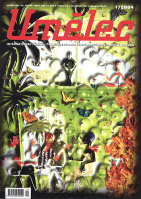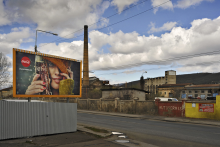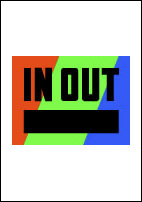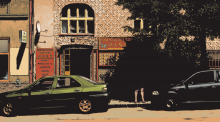| Zeitschrift Umělec 2004/1 >> Al Hurra Guma Guar !Guma Guar: Cell, Gallery Jelení, Prague, 15 December 2003 – 26 January 2004;Guma Guar: Reconstructing the Utopia System Rules, A.M. 180, 17 December 2003 – 8 January 2004 | Übersicht aller Ausgaben | ||||||||||||
|
|||||||||||||
Al Hurra Guma Guar !Guma Guar: Cell, Gallery Jelení, Prague, 15 December 2003 – 26 January 2004;Guma Guar: Reconstructing the Utopia System Rules, A.M. 180, 17 December 2003 – 8 January 2004Zeitschrift Umělec 2004/101.01.2004 Jiří Ptáček | geschichte | en cs |
|||||||||||||
|
Mass media makes full use of its fictional potential. Al Jazeera is waging an undeclared information war against CNN, and both have emblazoned the same words on their artillery: “information” and “exclusive.” Less openly, they admit having “spheres of external interest,” and they divert us along with them into the world of speculation and X-files. The paradoxical meeting points of investigation, the desire to have a unique position in the media spectrum, political or economic lobbying and awareness of who the target group is, all create information filters and at the moment we come to realize the many interpretations of a single event, we falter and look around in confusion, expecting someone to offer us a consensus.
And they stoke the fires: Bush’s free Al Hurra, the BBC — that decaying guarantee of objectivity — and the dozens of equivocal TV channels: satellite, cable, television license, commercial… and that’s only the TV branch of the sturdy tree of mass media. The global village is not burgeoning in quality, and it seems that with the current cacophony of viewpoints it is never going to happen. Cut. National News. In August 2003, thousands of Europeans got together for another unauthorized Czechtekk. The media carried news about the subculture, techno and drugs — thereby establishing the existence of a unified mass of alternative lifestyle. The public was introduced to the highlights, but soon there was another cut and a new exclusive. As soon as the ravers no longer gelled as a mass, they stopped being interesting. In media language, the term “exclusive” gets the endorphins or adrenaline pumping. TV reporting is mostly effective pornography. The word “live” at the bottom of the screen is no ornament. Civilization is obsessed by presence. Maybe that’s because it is so excited by its ability to medialize, and the basic element of civilization, the individual, is willingly reduced to a chain of physiological reactions. A gaze back after a period of time shows an event to be a too tangled system, and thus the past is reduced to history, from which the media carefully choose that which can, under rules set in their favor, once again light up the bright neon word “LIVE.” In a pervasive atmosphere of chiliasm, it is not advisable to speak about the future, because any talk about the future is an increasingly obvious indictment against “live.” We could speculate endlessly on which human attributes the mass media massage exploits. But one example of advanced media politics is a TV broadcast delayed by a few minutes: digital technology eliminates anything that might disturb the smooth course of the predetermined level of brain center stimulation. “Live” is faked in the interest of retaining its mass media interpretation. The machinery of media power kicks up polemic on many levels — art is no exception. Simultaneous exhibitions of the art group Guma Guar in the galleries in Jelení and A.M. 180 in Prague are eloquent examples of how polemical confrontation can be carried out in a sophisticated manner. Guma Guar’s entrance into a particular context is typically one of intervention. Whether they’re distributing activist stickers in the streets or clubs, showing up at Czechtekk with their own sound system or organizing an exhibition of artifacts, they choose mainstream production, but the intonation of the work always wrenches it free. In Jelení this distance was obvious. Their large-surface prints, lightboxes and projections installed as if they were in a museum were their most conservative entry thus far in the discourse of exhibition organization. But the artifacts demonstrated that an explosive cocktail dwells within classical forms of artistic communication. Guma Guar “broadcasts” their interpretation of events: the burned bodies of the victims from the last “Gulf” war, downloaded from diabolic Al Jazeera, were installed in elegant IKEA lightboxes; a fast edited medley of media images (soundless VJ-ing, sinister visual scratching of the signs of ideological totality); a TV walkman and headset with the interrogations of the captured American soldiers — simply the dark side of the war and its mediation, an attack on the propriety and pampered awareness of what also (!) creates a “conflict of cultures and seeks for a global balance of forces and power.” The mediators (the media) and their ideological tactics play the central role in this process, Guma Guar points out. But is their intention simply to open our eyes? The exhibition in Jelení confirmed that their position is more complicated than that. The series of large-surface prints looked like direct downloads from the BBC, but something was wrong. The information on the red information bars connects to the TV images in a comical, absurd or violent way. For instance, the words at the bottom of the screen tell us that the nuclear bomb exploding is a live broadcast. In another print a grinning Conan the Barbarian (Governor Schwarzenegger) lets an ordinary mortal touch the blade of his murderous sword — but in the text bar it is written that this is a depiction of a meeting between the British prime minister and the American president. Does Guma Guar look for moments when mass media dramaturgy loses control over the material and thus accidentally reveals its underlying methods? Or does Guma Guar just play with the combinations of pictures and texts to evoke a reaction to more or less successful satires with political subtext? As long as there is nothing to offer confirmation one way or the other, both interpretation are easily possible. When Guma Guar deals with aspects of purpose masking (what else is political correctness?), they are forced to use them in order to lead us into similar uncertainty. In the end, are we to continue to believe that the charred bodies in the lightboxes are the victims of war? Who wags the dog anyway? George Bush, CNN, Guma Guar? Everybody? And are there more dogs or is there just one? The limits of manipulation and demagogy blur, as long as we are unable to “believe” wholeheartedly in the presented ethical interpretation of reality. And Guma Guar adds to the imaginary scribbled slogan “Believe me, you shouldn’t have been shown this!” the notion that “If you do believe, you can truly slip up.” This gives mass media politics the refutable thesis: for the person who is interested in the world around him, the authenticity of contemporary life doesn’t lie in the registration into a given identity, but in the constant deregistering. This naturally expands into active civil disobedience, which does not entail the view of actually believing in what you do, because to do so would mean that your view would then become (once again) the one and only monstrously totalitarian truth of life. External disobedience towards the presented reality remains the foundation of this position, because of the inner desire to be free of the presentation. Reality consequently eludes our grasp, but it is important to admit that this is a characteristic of the way in which we desire to grasp it. The world continues to whoosh forward full of human pain, and Guma Guar offers no solution. And if, however, they indicate partial rules of this process, the next minute they turn back to their own methods of presentation and deconstruct them by making them unreliable. Mass media as a powerful source of truth about reality have the ability to register us into a reality, painlessly placing us within it. Guma Guar sheds light on the limits, where the primary action and subsequent reaction fluctuate. Guma Guar used somewhat differently distorted mirrors in A.M. 180. Gallery Jelení is a research workshop in the Czech art community, while A.M. 180 is part of live café Utopia. Large photos of a meadow with a spruce forest in the background, a photo of a car trunk full of Czech hotdog buns and video animation covered the walls and filled the space of the two halls, demonstrating that this wasn’t a collection of non-homogenous material, but a conceptual whole. A flashing mixture of young people’s faces bearing the attributes civilization’s alternatives — dreadlocks, piercings — moving so quickly that it actually became one morphing subcultural mutant. All the works were relicts of Czechtekk, acquired at a visual angle that does not often appear in the public space of mass media. Photos of the landscape of the space where this massive happening took place, but several weeks later. Only the overgrown bedsores in the grass were evidence that an impromptu “human camp” had risen on this spot. Locally Czechtech was at the center of discussion and reflected on widely. Yet it was a problem to recognize it here. The images in magazines and on TV were alien. Ravers were either completely excluded, or transformed by animation into a strange “superindividual.” The mass, presented sequentially from one individual to the next, ceases to have the collective mentality that we so often find within it. What seems so clearly expressed in mass media’s “live,” spreads to the unsystematic archeology of “detail” and “what has already ended” by Guma Guar. They are no more recognizable than any other event for which we deny the constructions of a start and end, explicitness and generalization. Guma Guar doesn’t defend any of the intentions or ideas of the action; they observe Czechtech from a distance and highlight the differences within the publicly unified entity. As if they are using the structures we store in our minds about the event. And once again (though less distinctly) they allude to the meaning of the mass media inter-mediator, by which we orient ourselves in the contemporary world.
01.01.2004
Empfohlene Artikel
|
|||||||||||||
|
04.02.2020 10:17
Letošní 50. ročník Art Basel přilákal celkem 93 000 návštěvníků a sběratelů z 80 zemí světa. 290 prémiových galerií představilo umělecká díla od počátku 20. století až po současnost. Hlavní sektor přehlídky, tradičně v prvním patře výstavního prostoru, představil 232 předních galerií z celého světa nabízející umění nejvyšší kvality. Veletrh ukázal vzestupný trend prodeje prostřednictvím galerií jak soukromým sbírkám, tak i institucím. Kromě hlavního veletrhu stály za návštěvu i ty přidružené: Volta, Liste a Photo Basel, k tomu doprovodné programy a výstavy v místních institucích, které kvalitou daleko přesahují hranice města tj. Kunsthalle Basel, Kunstmuseum, Tinguely muzeum nebo Fondation Beyeler.
|




































 We Are Rising National Gallery For You! Go to Kyjov by Krásná Lípa no.37.
We Are Rising National Gallery For You! Go to Kyjov by Krásná Lípa no.37.
Kommentar
Der Artikel ist bisher nicht kommentiert wordenNeuen Kommentar einfügen